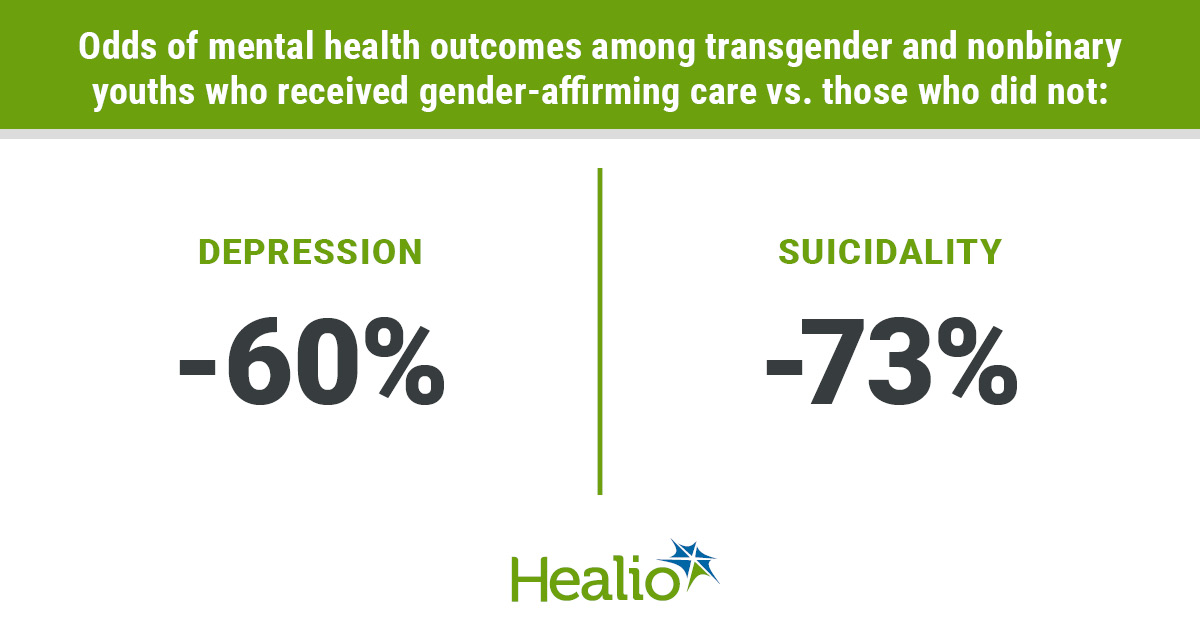Assessing Gender Euphoria To Enhance Transgender Mental Health Services

Table of Contents
Understanding Gender Euphoria and its Significance
Gender euphoria, in contrast to gender dysphoria, refers to the intense feelings of joy, relief, and validation experienced when one's gender identity aligns with their presentation and social experience. It's the feeling of being truly oneself, a sense of rightness and belonging. Experiencing gender euphoric feelings is not simply the absence of dysphoria; it is a powerful positive emotion intrinsically linked to well-being.
The significance of positive emotions in the transition process cannot be overstated. A focus solely on alleviating distress neglects the equally important aspect of fostering joy and self-acceptance. While gender dysphoria represents the distress caused by a mismatch between one's gender identity and assigned sex, gender euphoria embodies the positive affirmation and sense of wholeness that comes from gender alignment. These are not mutually exclusive experiences; many transgender individuals experience both simultaneously throughout their transition.
-
Examples of gender euphoria:
- Feeling comfortable and confident in one's chosen clothing and appearance.
- Experiencing positive social interactions and acceptance from others.
- Expressing oneself authentically without fear of judgment.
- Enjoying activities and hobbies that align with one's gender identity.
- The simple joy of using one's chosen name and pronouns.
-
Impact on mental well-being: Research suggests a strong positive correlation between experiencing gender euphoria and improved mental health outcomes. Increased feelings of self-worth and acceptance can significantly reduce anxiety, depression, and suicidal ideation.
-
Role in successful transition: The presence and intensity of gender euphoria can serve as a valuable indicator of transition success. It reflects a deeper sense of congruence and can predict better overall adjustment and mental health.
Assessing Gender Euphoria in Clinical Settings
Currently, while standardized assessment tools for gender dysphoria are readily available, equivalent instruments for measuring gender euphoria are less developed. Clinicians often rely on interviews and observations to gauge the presence and intensity of positive experiences.
-
Methods for assessment:
- Semi-structured interviews: Open-ended questions allow individuals to describe their experiences of experiencing gender euphoria in their own words.
- Qualitative data collection: Patient narratives provide rich insight into the nuances of gender euphoric feelings.
- Observation: Observing a client's body language, confidence, and self-expression can provide valuable qualitative information.
- Questionnaires: While limited, the development of specific questionnaires focusing on positive aspects of gender affirmation are vital.
-
Limitations of current assessment tools: There's a critical need for standardized, validated questionnaires and scales explicitly designed to measure gender euphoria. Existing instruments often focus primarily on dysphoria, neglecting the positive aspects of the transgender experience.
-
Importance of qualitative data: Incorporating qualitative data alongside quantitative measures provides a more holistic understanding of the client's experience, enriching the assessment beyond simple numerical scores.
-
Integrating assessment into existing protocols: Simple additions to existing intake forms, including questions about positive gender-affirming experiences, can greatly improve assessment practices.
Utilizing Gender Euphoria to Improve Treatment Strategies
Understanding and promoting sources of gender euphoria is key to crafting effective treatment plans. A holistic approach that acknowledges and builds upon client strengths, in addition to addressing challenges, is crucial.
-
Tailoring treatment plans: Treatment should be individualized, focusing on enhancing gender euphoric feelings and promoting self-acceptance.
-
Focusing on strengths and resources: Instead of solely addressing challenges and dysphoria, clinicians should identify and build on the client's existing strengths and resources.
-
Collaborative care model: Adopting a collaborative care model empowers transgender individuals to participate actively in shaping their treatment goals and strategies.
-
Examples of interventions that promote gender euphoria:
- Social support groups: Connecting with others who share similar experiences fosters a sense of community and belonging.
- Affirmation-based therapy: Therapy focused on validating the client's gender identity and self-expression.
- Creative expression activities: Art, music, and writing can provide outlets for self-discovery and affirmation.
- Gender-affirming surgeries and hormone replacement therapy: These can be critical in promoting body acceptance and gender euphoric feelings.
-
Measuring treatment effectiveness: The degree of gender euphoria experienced by the client can serve as a key indicator of treatment success.
-
Importance of ongoing support: Continued support is crucial, even after the initial stages of transition, to address evolving needs and maintain high levels of well-being.
Future Directions in Research and Clinical Practice
Further research is urgently needed to fully understand the multifaceted nature of gender euphoria and its impact on overall health outcomes.
-
Need for further research: More robust studies exploring the measurement of gender euphoria, its long-term effects, and its relationship to various health outcomes are essential.
-
Development of new assessment tools: The creation of comprehensive and culturally sensitive assessment tools specifically designed to measure gender euphoria is a high priority.
-
Training and education for healthcare professionals: Comprehensive training on assessing and incorporating gender euphoria into clinical practice must be prioritized for all healthcare professionals working with transgender individuals.
-
Areas for future research:
- Longitudinal studies examining the long-term impact of gender euphoria on mental and physical health.
- Research exploring the experiences of transgender individuals from diverse backgrounds and cultural contexts.
- Studies investigating the interplay between gender euphoria and other factors influencing well-being.
-
Collaboration between researchers and clinicians: Close collaboration is crucial to ensure that research findings are effectively translated into practice.
Conclusion
Assessing gender euphoria is not simply an add-on; it is essential for providing comprehensive and effective transgender mental health services. By understanding and promoting gender euphoric feelings, clinicians can create more person-centered and empowering treatment plans, leading to improved mental health outcomes and a more positive transition journey. The incorporation of both qualitative and quantitative assessments of gender euphoria offers a more complete picture of the individual's experience, guiding treatment strategies and measuring success. We urge healthcare professionals to prioritize learning more about assessing gender euphoria and integrating this knowledge into their clinical practice. This step is crucial for providing better, more affirming, and holistic care to their transgender clients. Further research and development in this area are vital to ensuring that all transgender individuals have access to the support they need to thrive.

Featured Posts
-
 Hamer Bruins Moet Met Npo Toezichthouder Over Leeflang Praten
May 15, 2025
Hamer Bruins Moet Met Npo Toezichthouder Over Leeflang Praten
May 15, 2025 -
 Witness Testimony Cassie Ventura Recounts Experiences With Sean Combs
May 15, 2025
Witness Testimony Cassie Ventura Recounts Experiences With Sean Combs
May 15, 2025 -
 A Second Chance In Blue The Story Of A Dodgers Comeback
May 15, 2025
A Second Chance In Blue The Story Of A Dodgers Comeback
May 15, 2025 -
 Max Muncy Speaks Out Addressing The Arenado Trade Rumors And Their Impact On The Dodgers
May 15, 2025
Max Muncy Speaks Out Addressing The Arenado Trade Rumors And Their Impact On The Dodgers
May 15, 2025 -
 The 2020 Election A Deep Dive Into Trumps And Bidens Campaigns
May 15, 2025
The 2020 Election A Deep Dive Into Trumps And Bidens Campaigns
May 15, 2025
